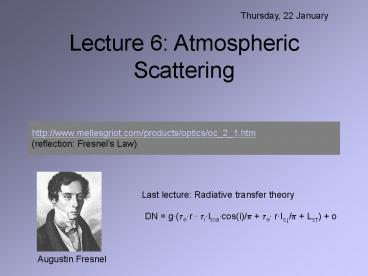Lecture 6: Atmospheric Scattering - PowerPoint PPT Presentation
1 / 25
Title: Lecture 6: Atmospheric Scattering
1
Thursday, 22 January
Lecture 6 Atmospheric Scattering
http//www.mellesgriot.com/products/optics/oc_2_1.
htm (reflection Fresnels Law)
Last lecture Radiative transfer theory
DN g(ter tiItoacos(i)/p te rIs?/p
Ls?) o
Augustin Fresnel
2
Atmospheric Effects
Mauna Loa, Hawaii
Ltoa r te (ti I toacos(i) Is? )/p Ls?
Ltoa r a b
3
Simulated scene viewed
with scattering
without scattering
4
Why do we care about scattering? - fundamental
process in radiative transfer and
remote sensing - must be accounted for to
recover quantitative data about surfaces
This image is entirely of scattered light
5
Landscapes with and without heavy atmospheric
aerosol content
Gusav Mie
6
Image processing x(y-b)/a can partially remove
atmospheric effects
7
Dust regionally affects images
China, SeaWifs
8
Dust regionally affects images
9
When you may not need to worry about atmospheric
effects
Atmospheric effects may not get in the way of
your analysis and therefore need not
be dealt with photointerpretation
classification
Atmospheric effects are all or partly removed by
scene-based calibrations (such as the empirical
line approach). Therefore, they need not be
dealt with further provided the atmosphere over
the scene is homogeneous
10
When you need atmospheric compensation most
When you wish to do quantitative spectral
analysis When you need to compare image spectral
data with lab data - for composition type
identification, for example
11
When do you need atmospheric compensation?
- Low elevation
- Variable elevation
- Off-nadir viewing
- Image channels near
- water bands (e.g.,
- MASTER-40 7.9µm)
- Haze, dust
Again atmospheric compensation is not always
feasible
12
Transmissivity decreases with view angle
nadir
oblique
0.4-0.7 µm - Vis
0.7 2.5 µm NIR-SWIR
8-12 µm LWIR
3-5 µm MIR
13
Transmissivity increases with ground elevation
top of mountain
base of mountain
SWIR
TIR
MIR
VNIR
0.4 µm
12 µm
14
Path spectral radiance Ls?(l) increases with view
angle
Mt. Rainier - TIR MASTER data
oblique
Spectral radiance, W/m2/sr/µm
nadir
8 µm
12 µm
Wavelength
15
Path spectral radiance Ls?(l) decreases with
elevation
Base of mountain
Spectral radiance, W/m2/sr/µm
Top of mountain
12 µm
8 µm
16
Scattering is controlled by the wavelength and
the size of the scattering particles
Molecules
Amplitude proportional to l-4
Scattering in the atmosphere is dominantly
Rayleigh and Mie scattering
17
Rayleigh Scattering
Lord Rayleigh (John William Stutt)
18
Dust
l0.1- 10 µm
40
30
lltltd
20
Non-selective scattering
10
0
0.4
0.5
0.6
0.7
0.8
0.9
Wavelength, µm
Clouds
19
Mie Scattering
20
(No Transcript)
21
Types of scattering envelopes
Uniform scattering
Back scattering
Forward scattering
22
Color Ratio Images
TITAN
After learning about atmospheric scattering, how
would you interpret the colors and intensities of
this picture?
23
To what can you attribute the ratio differences
you see?
H1) Color on Titan?
H2) Bad calibration?
B/R
RATIO (aBLUEb)/(cREDd)
Suppose ac1, d0, b3
TITAN
If scene is dark, RATIO increases a lot IF
scene is light, RATIO increases less
24
What do you attribute the ratio differences to?
H1) Color on Titan?
H2) Bad calibration?
RATIO (aBLUEb)/(cREDd)
B/R
TITAN
HOW CAN YOU TEST H1 H2? IS THERE AN H3?
25
Midterm is coming up in a couple weeks. 50
minutes, questions drawn from lab, reading,
lectures Short answers You will not be asked to
do complicated mathematics, - but expect some
simple calculations One question will involve
explaining your logic or reasoning - this is
as important as your answer































